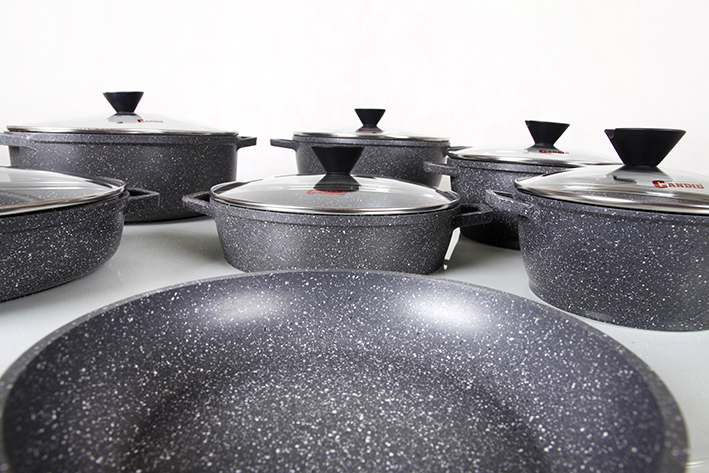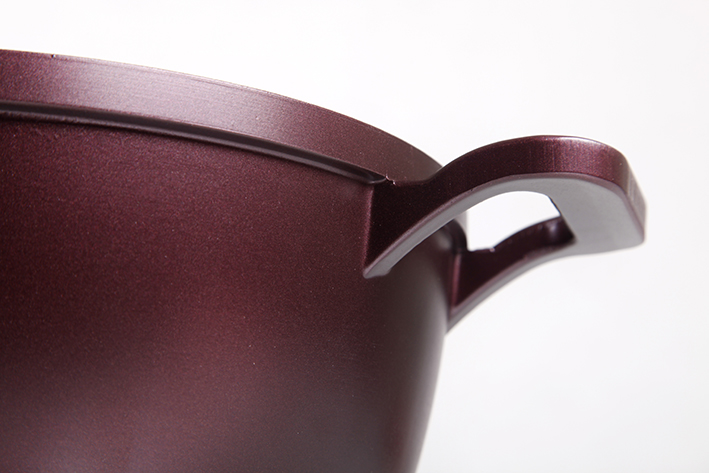Excellence
The property of Candid die cast containers is its uniform heat distribution. This helps to cook protein foods properly.

The property of Candid die cast containers is its uniform heat distribution. This helps to cook protein foods properly.

The method of production of these dishes is in the same way that it is currently used in developed countries to produce complex car and aircraft parts. The production of these dishes is done with advanced Die Cast technology. In this method, high-pressure melted aluminum alloy is injected into steel molds. After cooling, the piece is removed from the mold and the aluminum surface is mirror polished.
The aluminum piece is then subjected to a high-pressure sandblasting process until the aluminum surface reaches a rough surface on a micron scale. This surface roughness creates the right conditions for a strong physical bond between the aluminum and the Teflon or ceramic coating in the next step. After sandblasting, the parts are placed on the conveyor of the automatic spraying line and without the intervention of the hand and with the help of modern technology, they are exposed to spraying non-stick Teflon or ceramic materials and different colors in one or more layers with uniform thickness.

The high thickness of the aluminum makes the body stronger and the life of the container longer compared to the pressed containers. For example, you may have the experience that the bottom of the pressed container gets deformed and rises after a while of use. This is due to the low strength of the thin body of these dishes and makes the oil no longer spreads evenly inside the dish and no oil will remain at the core of the container.

The high thickness of aluminum compared to pressed containers allows the container to hold the heat and spread it evenly. Also, the low thickness of the bottom of the dishes causes the flame to transfer more heat to the inside coating of the container at the contact point with the bottom of the container the Teflon coating at the ringed shape of flame contact will be damaged more.

The crispy scorched rice detaching from the bottom of the dish is of special importance in Iranian cooking culture. Die cast dishes as for the high thickness of the bottom compared to the common pressed containers in the market make better scorched rice. The thickness of the bottom of these containers in case of being standard and properly designed is at least 4 to 5 millimeter. This thickness improves quality of cooking and brings you the following benefits.

The method of production of these dishes is the same as it is currently used in developed countries to produce complex parts for cars and airplanes. The production of these dishes is done with advanced die cast technology. In this method, melted aluminum alloy is injected with high pressure into carbon steel molds. After cooling, the piece is removed from the mold and after trimming and initial polishing process, the aluminum surface is mirror polished. The aluminum piece is then subjected to a high-pressure sandblasting process until the aluminum surface reaches a rough surface on a micron scale.This surface roughness creates the right conditions for a strong physical bond between the aluminum and the Teflon or ceramic coating in the next step. After sandblasting, the parts are placed on the conveyor of the automatic spraying line and by using nozzles and electronic eyes and with the help of modern technology, they are exposed to get sprayed by non-stick Teflon or ceramic materials and different colors in one or more layers with uniform thickness. After the process of cooking the sprayed layers, the parts are machined by automatic CNC machines and transferred to the packaging unit.
Advantages of die-cast aluminum containers:
1. The high thickness of aluminum allows the container to hold heat and distribute it evenly, since the flame in the point of contact to the bottom of container(with low thickness) transfers more heat to the inside coating of the container and damages the nonstick inside coating at the ringed shape of flame contact.
2- The high thickness of aluminum makes the body stronger and increases the lifetime of the container. For example, you may have experienced that the bottom of the pressed containers get deformed convex and as a result the oil spreads evenly inside the dish.

In fact, cast iron, due to its high resistance to consecutive heating and cooling, is one of the types of iron alloys that replaced heavy and brittle containers made of stone many years ago. Today in our country, containers made of alloy aluminum are mistakenly called cast iron containers. The average weight of a pot(size:24) made of aluminum alloy is about 1 kg, while a pot of the same size, if made of cast iron, is about 3 kg; Therefore, it is enough for an experienced person who is familiar with metals to hold the container in his hand and understand this issue. Cast iron utensils are now mostly used in industrial kitchens. Cast iron utensils have given way to aluminum competitors for years due to their heavy weight, high price, production problems and lack of proper heat transfer.
